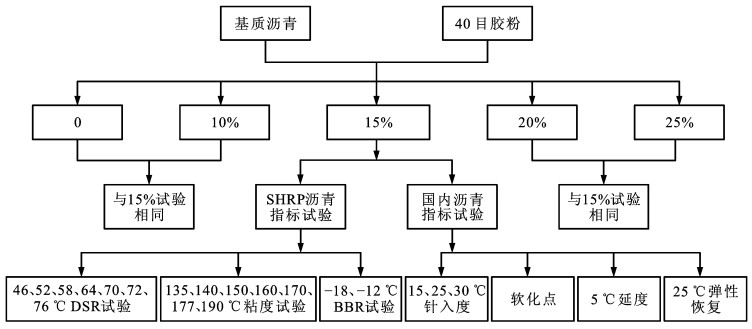-
摘要: 为统一橡胶沥青性能试验的评价指标, 分别采用不同胶粉掺量对70#和90#的基质沥青进行改性, 基于中国规范中的针入度、延度、软化点和弹性恢复试验以及Superpave中的动态剪切流变试验、布氏旋转粘度试验和弯曲梁流变试验等对橡胶沥青进行了性能评价。研究结果表明: 胶粉的添加能显著改善沥青的高温性能, 显著降低沥青的温度敏感性, 但增大了沥青的高温粘度, 增加了沥青混合料的拌和与压实难度; 胶粉的溶胀作用会导致针入度的试验结果出现较大误差, 因此, 不建议采用针入度试验来评价橡胶沥青的性能; 软化点可作为橡胶沥青高温性能的一个评价指标, 对于90#基质沥青, 胶粉掺量分别为10%、15%、20%和25%时的软化点比未掺胶粉时的软化点分别提高了11.23、11.97、15.18、21.10 ℃, 对于70#基质沥青, 胶粉的添加则使其软化点分别提高了4.02、8.18、12.83、14.45 ℃, 因此, 胶粉对70#基质沥青软化点的影响效果要大于对90#基质沥青的影响效果; 胶粉对沥青低温性能的改善效果会随着温度的下降而降低, 在研究胶粉对沥青低温性能的影响程度时, 弯曲梁流变试验的结果比低温延度试验的结果更加明显, 且由于橡胶沥青的低温延度较小, 试验过程中容易产生较大误差, 因此, 建议采用弯曲梁流变试验评价橡胶沥青的低温性能。Abstract: To unify the performance evaluation indicators of asphalt rubber, 70# and 90# base asphalts were modified with different rubber powder contents. The performance tests of rubber asphalts were conducted by Chinese specific tests such as penetration test, ductility test, softening point test and elastic recovery test, and Superpave methods such as dynamic shear rheology(DSR)test, Brookfield rotary viscosity test, and bending beam rheology(BBR)test. Analysis result shows that the addition of rubber powder can improve the high-temperature performance and reduce the temperature sensitivity of asphalt, but increase the viscosity of asphalt at high temperature and increase the difficulties in asphalt mixing and compaction. The swelling of rubber powder would lead big error in penetration test, so it is not recommended to apply penetration test in evaluation of rubber asphalt performance. Softening point can be regarded as one of evaluation indicators for high-temperature performance of rubber asphalt. For 90# base asphalt, its softening point increases by 11.23, 11.97, 15.18 and 21.10 ℃ when the rubber powder content is 10%, 15%, 20% and 25% respectively. For 70# base asphalt, its softening point increases by 4.02, 8.18, 12.83 and 14.45 ℃ when the rubber powder content is 10%, 15%, 20% and 25% respectively. It is also found the influence of softening point caused by rubber powder is larger on 70# base asphalt than on 90# base asphalt. The improvement of rubber powder on the low-temperature performance of asphalt would decease with the decrease of temperature. To test the improvement of rubber powder on the low-temperature performance of asphalt, BBR test is more significant than low-temperature ductility test. Besides, big error will produce in low-temperature ductility test process because of its small value. Therefore, it is recommended to apply BBR test for the low-temperature performance evaluation of rubber asphalt.
-
Key words:
- road engineering /
- rubber asphalt /
- laboratory test /
- performance test /
- Superpave /
- evaluation indicator
-
表 1 壳牌90# 和70# 沥青基本性能
Table 1. Fundamental properties of Shell 90# and 70# asphalts

表 2 胶粉的技术指标
Table 2. Technical indicators of rubber powder

表 3 橡胶沥青针入度方差分析结果
Table 3. Variance analysis result of rubber asphalt penetration

表 4 橡胶沥青软化点方差分析结果
Table 4. Variance analysis result of rubberasphalt softening point

表 5 橡胶沥青延度和弹性恢复方差分析结果
Table 5. Variance analysis results of ductility andelastic recovery for rubber asphalt

表 6 不同胶粉掺量下沥青抗车辙因子的差异性分析结果
Table 6. Difference analysis results of rutting resistance factorsat different rubber powder contents

表 7 橡胶沥青粘度-温度曲线拟合结果
Table 7. Fitting result of rubber asphalt viscosity-temperature curve

表 8 S(t)方差分析结果
Table 8. Variance analysis result of S(t)

-
[1] BRESSETTE T, ZHOU H P, STONEX A, et al. Asphalt rubber and its potential use in China[C]∥ICCTP. Seventh International Conference of Chinese Transportation Professionals. Shanghai: ICCTP, 2007: 776-785. [2] 胡彪, 张晓雨, 赵新, 等. 废旧橡胶制品资源化利用研究进展[J]. 材料导报, 2014, 28(2): 75-79. https://www.cnki.com.cn/Article/CJFDTOTAL-CLDB201403016.htmHU Biao, ZHANG Xiao-yu, ZHAO Xin, et al. Research progress on resource utilization of waste rubber products[J]. Materials Review, 2014, 28(2): 75-79. (in Chinese) https://www.cnki.com.cn/Article/CJFDTOTAL-CLDB201403016.htm [3] HE Z Y, LU Z F, ZHANG W W. Performance study on rubber powder modified asphalt of waste tire[C]∥ICCTP. Tenth International Conference of Chinese Transportation Professionals. Beijing: ICCTP, 2010: 3272-3278. [4] 何立平, 申爱琴, 谢成, 等. 橡胶沥青结合料性能正交试验[J]. 长安大学学报: 自然科学版, 2014, 34(1): 7-12. https://www.cnki.com.cn/Article/CJFDTOTAL-XAGL201401003.htmHE Li-ping, SHEN Ai-qin, XIE Cheng, et al. Orthogonal test for rubber asphalt properties[J]. Journal of Chang'an University: Natural Science Edition, 2014, 34(1): 7-12. (in Chinese) https://www.cnki.com.cn/Article/CJFDTOTAL-XAGL201401003.htm [5] ZHOU H P, HOLIKATTI S, VACURA P. Caltrans use of scrap tires in asphalt rubber products: a comprehensive review[J]. Journal of Traffic and Transportation Engineering: English Edition, 2014, 1(1): 39-48. doi: 10.1016/S2095-7564(15)30087-8 [6] NAVARRO F J, PARTAL P, MARTINEZ-BOZA F, et al. Influence of crumb rubber concentration on the rheological behavior of a crumb rubber modified bitumen[J]. Energy and Fuels, 2005, 19(5): 1984-1990. doi: 10.1021/ef049699a [7] MAMLOUK M, MOBASHER B. Cracking resistance of asphalt rubber mix versus hot-mix asphalt[J]. Road Materials and Pavement Design, 2004, 5(4): 435-451. doi: 10.1080/14680629.2004.9689980 [8] MULL M A, STUART K, YEHIA A. Fracture resistance characterization of chemically modified crumb rubber asphalt pavement[J]. Journal of Materials Science, 2002, 37(3): 557-566. doi: 10.1023/A:1013721708572 [9] KIM S, LOH S W, ZHAI H, et al. Advanced characterization of crumb rubber-modified asphalts, using protocols developed for complex binders[J]. Transportation Research Record, 2001(1767): 15-24. https://trid.trb.org/view/695988 [10] SPECHT L P, KHATCHATOURIAN O, BRITO L A T, et al. Modeling of asphalt-rubber rotational viscosity by statistical analysis and neural networks[J]. Materials Research, 2007, 10(1): 69-74. doi: 10.1590/S1516-14392007000100015 [11] JEONG K D, LEE S J, AMIRKHANIAN S N, et al. Interaction effects of crumb rubber modified asphalt binders[J]. Construction and Building Materials, 2010, 24(5): 824-831. doi: 10.1016/j.conbuildmat.2009.10.024 [12] 徐东, 王新宽, 陈博. 橡胶沥青混合料老化再生及其路用性能研究[J]. 武汉理工大学学报, 2012, 34(10): 48-52. doi: 10.3963/j.issn.1671-4431.2012.10.011XU Dong, WANG Xin-kuan, CHEN Bo. Research on properties of reclaimed rubber modified asphalt mixture[J]. Journal of Wuhan University of Technology, 2012, 34(10): 48-52. (in Chinese) doi: 10.3963/j.issn.1671-4431.2012.10.011 [13] 关永胜, 谈至明, 张志祥. 间断级配橡胶沥青混合料抗车辙性能[J]. 同济大学学报: 自然科学版, 2013, 41(5): 705-709. doi: 10.3969/j.issn.0253-374x.2013.05.012GUAN Yong-sheng, TAN Zhi-ming, ZHANG Zhi-xiang. Rutting performance of gap graded asphalt rubber mixtures[J]. Journal of Tongji University: Natural Science, 2013, 41(5): 705-709. (in Chinese) doi: 10.3969/j.issn.0253-374x.2013.05.012 [14] 杨永顺, 曹卫东, 李英勇, 等. 橡胶沥青制备工艺及其性能的研究[J]. 山东大学学报: 工学版, 2008, 38(5): 10-13. https://www.cnki.com.cn/Article/CJFDTOTAL-SDGY200805004.htmYANG Yong-shun, CAO Wei-dong, LI Ying-yong, et al. Preparation process and performance of asphalt-rubber[J]. Journal of Shandong University: Engineering Science, 2008, 38(5): 10-13. (in Chinese) https://www.cnki.com.cn/Article/CJFDTOTAL-SDGY200805004.htm [15] 黄卫东, 王伟, 黄岩, 等. 橡胶沥青混合料高温稳定性影响因素试验[J]. 同济大学学报: 自然科学版, 2010, 38(7): 1023-1028. doi: 10.3969/j.issn.0253-374x.2010.07.015HUANG Wei-dong, WANG Wei, HUANG Yan, et al. Influencing factor research on high-temperature performance of asphalt rubber mixture[J]. Journal of Tongji University: Natural Science, 2010, 38(7): 1023-1028. (in Chinese) doi: 10.3969/j.issn.0253-374x.2010.07.015 [16] 于新, 孙文浩, 罗怡琳, 等. 橡胶沥青温度敏感性评价方法研究[J]. 建筑材料学报, 2013, 16(2): 266-270, 283. doi: 10.3969/j.issn.1007-9629.2013.02.015YU Xin, SUN Wen-hao, LUO Yi-lin, et al. Research on the evaluation index of temperature sensitivity of CRMA[J]. Journal of Building Materials, 2013, 16(2): 266-270, 283. (in Chinese) doi: 10.3969/j.issn.1007-9629.2013.02.015 [17] 凌天清, 李耀楠, 董强, 等. 橡胶颗粒对微表处性能的影响及其降噪效果[J]. 交通运输工程学报, 2011, 11(5): 1-5. http://transport.chd.edu.cn/article/id/201105001LING Tian-qing, LI Yao-nan, DONG Qiang, et al. Influence of rubber particles on micro-surfacing performance and its noise-reduction effect[J]. Journal of Traffic and Transportation Engineering, 2011, 11(5): 1-5. (in Chinese) http://transport.chd.edu.cn/article/id/201105001 [18] XIAO F P, AMIRKHANIAN S N. Laboratory investigation of utilizing high percentage of rap in rubberized asphalt mixture[J]. Materials and Structures, 2010, 43(1/2): 223-233. doi: 10.1617/s11527-009-9483-1 [19] AKISETTY C K, LEE S J, AMIRKHANIAN S N. High temperature properties of rubberized binders containing warm asphalt additives[J]. Construction and Building Materials, 2009, 23(1): 565-573. doi: 10.1016/j.conbuildmat.2007.10.010 [20] THODESEN C C. Development of prediction models of high temperature crumb rubber modified binders[D]. Clemson: Clemson University, 2008. [21] WANG Hai-nian, YOU Zhan-ping, MILLS-BEALE J M, et al. Laboratory evaluation on high temperature viscosity and low temperature stiffness of asphalt binder with high percent scrap tire rubber[J]. Construction and Building Materials, 2012, 26(1): 583-590. doi: 10.1016/j.conbuildmat.2011.06.061 -





 下载:
下载:








